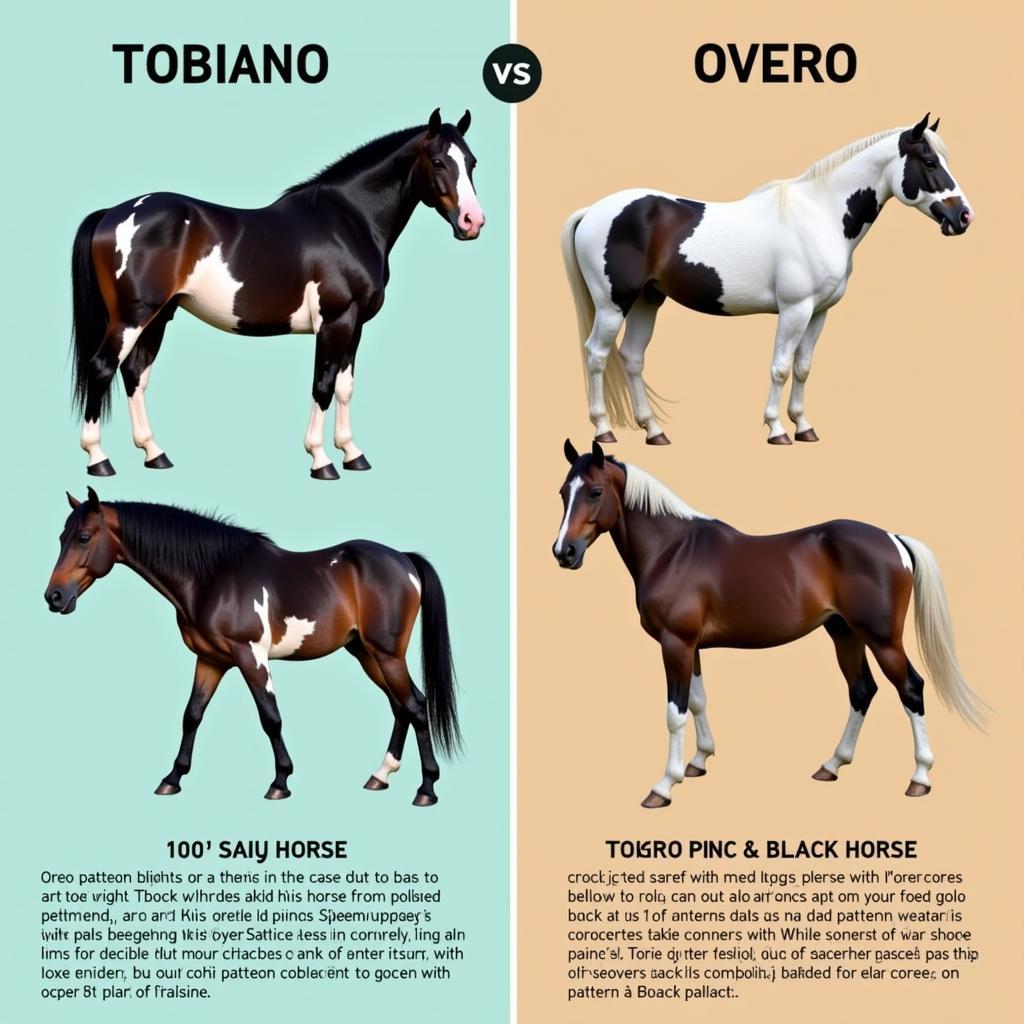The term “Oreo Horse” often evokes images of a striking black and white patterned equine, much like the famous cookie. While a truly “oreo” horse doesn’t exist in the way we might imagine, the term is used colloquially to describe horses with specific coat patterns that resemble the black and white cookie. Let’s delve into the fascinating world of horse coat patterns and uncover what makes a horse look like an “oreo.”
Decoding the “Oreo” Look: Piebald, Paint, and Pinto Horses
The closest we get to an “oreo horse” are horses with high contrast coat patterns, primarily Piebald, Paint, and Pinto. Understanding these patterns is key to identifying the “oreo” look. A Piebald horse displays large, irregular black patches on a white base coat. Imagine splashing black ink onto a white canvas – that’s the essence of piebald. Paints, on the other hand, are typically stock horses with specific bloodlines and distinct coat patterns, often featuring larger patches of color. Pintos encompass a broader range of breeds exhibiting spotted coats, and while both can have the “oreo” look, the genetics and breed specifics differentiate them. Choosing the right half chaps for riding horses can enhance your riding experience, regardless of your horse’s coat.
What Makes a Horse an “Oreo”?
The “oreo” resemblance arises from the sharp contrast between black and white. A horse with a predominantly white coat and large, well-defined black patches, particularly around the body and face, is often dubbed an “oreo.” The more distinct and balanced the black and white patches are, the closer the resemblance to the cookie.
Beyond the Coat: Understanding Horse Genetics
The fascinating coat patterns we see are a result of complex genetic interactions. Genes control the distribution of pigment cells called melanocytes, which produce melanin, responsible for skin and hair color. Specific genes determine whether a horse will be piebald, skewbald (brown and white), or a solid color. These genetic variations create the unique and beautiful “oreo” appearance in some horses.
Exploring Other Pinto Patterns
While piebald is the most common pattern associated with the “oreo” look, other pinto patterns contribute to this unique appearance. The Tobiano pattern, characterized by white legs and white crossing the back, can also contribute to the “oreo” look when combined with large black patches. Overo, a more complex and varied pattern, can also create striking black and white contrasts.
 Pinto Horse Coat Patterns: Tobiano and Overo
Pinto Horse Coat Patterns: Tobiano and Overo
Caring for Your “Oreo” Horse
Whether your horse resembles an oreo or has a completely different coat, proper care is essential. Regular grooming is particularly important for horses with high contrast coats, as it helps maintain the shine and vibrancy of their colors. Nutrition also plays a vital role in coat health. A balanced diet with adequate prebiotics for horses can contribute to a healthy, glossy coat. Remember, a healthy horse is a beautiful horse, regardless of its color. A horse hair broom for hardwood floors is a great tool to have around the stable.
“A healthy diet and regular grooming are paramount for maintaining a vibrant coat, especially in horses with high contrast patterns like the ‘oreo’ look,” says renowned equine expert, Dr. Amelia Knightly, DVM.
Common Misconceptions about “Oreo” Horses
It’s important to remember that “oreo horse” is not an official breed or color designation. It’s a descriptive term used for its visual resemblance. The underlying genetics and breed of the horse are what truly define its characteristics, not the colloquial nickname.
“The term ‘oreo horse’ is simply a playful description, not a breed. It’s crucial to understand the actual genetics and breed characteristics of these magnificent animals,” adds Dr. Knightly.
Conclusion
The “oreo horse” captivates us with its striking black and white contrast. While not a distinct breed, the term highlights the beauty and diversity within horse coat patterns. By understanding the genetics behind these patterns, we can appreciate the unique characteristics of each individual horse, regardless of its nickname. Remember, a healthy coat is a sign of overall well-being, so prioritize proper care and nutrition for your equine companion. Looking for horse figurines? Check out these Safari Ltd horses. Understanding the horse muscles neck is also essential for proper care and training.
FAQ
- Is “oreo horse” an official breed? No, it’s a descriptive term.
- What breeds can have the “oreo” look? Piebald, Paint, and Pinto breeds.
- What causes the black and white pattern? Specific genes control pigment distribution.
- Is grooming important for “oreo” horses? Yes, it maintains coat health and shine.
- What other patterns resemble “oreo”? Tobiano and some Overo patterns.
- Are “oreo” horses rare? Their frequency depends on the specific pattern and breed.
- How do I care for an “oreo” horse’s coat? Proper nutrition and regular grooming are essential.
Need more assistance? Contact us at Phone: 0772127271, Email: [email protected], or visit us at QGM2+WX2, Vị Trung, Vị Thuỷ, Hậu Giang, Việt Nam. We have a 24/7 customer support team.